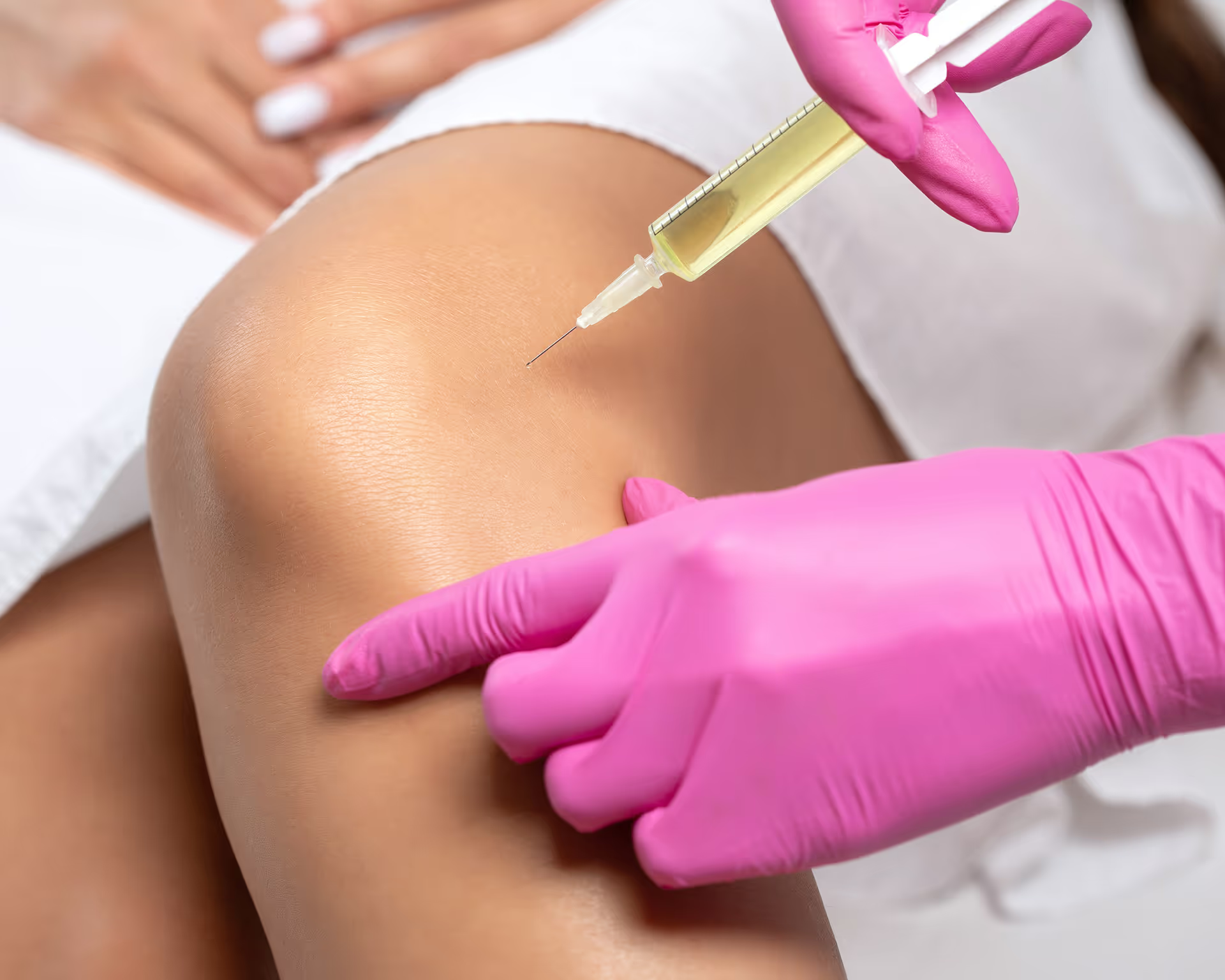PRP for Joint Pain
What to Expect
Discover all you need to know before, during and after your treatment!
Book a Treatment
Discover all you need to know before, during and after your treatment!
Book a TreatmentDuring your PRP for Joint Pain treatment, you can expect a professional and comfortable experience:
Blood Draw: The session begins with a standard blood draw, typically from your arm. The amount of blood drawn depends on the treatment area size.
Blood Processing: The collected blood is then placed in a centrifuge. This machine spins the blood at high speed to separate the plasma and platelets from the other blood components. The resulting substance is the platelet-rich plasma (PRP) which is rich in growth factors.
Injection of PRP: The prepared PRP is then injected into the targeted areas using a fine needle. The specific injection sites depend on your needs and the areas you wish to improve.
Sensation: During the treatment, you might feel a pinch or a burning sensation when the needle is inserted. Some patients report a feeling of pressure or mild pain when the PRP is injected into the joint.
Duration: The entire procedure usually takes about 60 minutes, depending on the treatment’s extent.
To ensure your PRP for Joint Pain treatment is most effective and safe, there are some guidelines prior to your appointment to follow.
Consultation: Schedule an initial consultation to discuss your joint pain and determine if PRP Therapy is right for you.
Medical History: Provide us with a complete medical history, including any medications or supplements you are taking.
Avoid Anti-Inflammatory Medication: Stop all anti-inflammatory medications for 2 weeks prior to injections (e.g. Advil, ASA, Aleve, Naprosyn, Voltaren, Arthrotec, and Celebrex.)
Hydration: Drink plenty of water before the procedure to ensure an easier blood draw.
Proper aftercare is crucial to maximize the benefits of your PRP for Joint Pain treatment and to ensure a safe and quick recovery.
Rest the Joint: It’s important to rest the treated joint for at least a few days after the injection. Avoid strenuous activities or heavy exercise that could strain the joint.
Ice Application: Applying ice to the injection site can help reduce any immediate swelling and discomfort. Use ice packs for 15-20 minutes at a time, several times a day, for the first 48-72 hours. Make sure to wrap the ice pack in a towel to protect your skin.
Avoid Anti-Inflammatory Medications: Post-PRP treatment, you should avoid taking anti-inflammatory medications for one week. These medications can interfere with the natural inflammatory process that PRP aims to utilize for joint healing.
Attend Follow-up Appointments: Follow-up with your provider as recommended to assess how well the joint is healing and discuss any concerns. These appointments are crucial to monitor your progress and plan any additional treatments if necessary.
Stay Hydrated and Maintain Nutrition: Good hydration and a balanced diet can aid in the recovery process. Some nutrients, particularly those that promote collagen production (like vitamin C and zinc), can be beneficial for joint health.
After receiving your PRP injection, it is advisable to avoid strenuous activities for several days. You may resume sporting activities only if you are pain-free during normal daily activities. Individuals who were taking anti-inflammatories should wait one week after completing all PRP treatments before resuming these medications.
Prior to your PRP treatment, please discontinue all anti-inflammatory medications for two weeks. This includes drugs such as Advil, ASA, Aleve, Naprosyn, Voltaren, Arthrotec, and Celebrex. It is crucial that you inform the nurse practitioner if you:
The number of PRP injections you will receive varies depending on the specific area being treated. Typically, patients undergoing treatment for osteoarthritis (OA) of the knee receive two to three injections, spaced two to four weeks apart.
The procedure takes about 60 minutes, including preparation and injection time.
PRP (Platelet-Rich Plasma) therapy can be beneficial for a range of conditions. Those with chronic joint pain, osteoarthritis, tendonitis, or ligament injuries are often good candidates. PRP can help with pain relief and promote healing in these cases. PRP therapy is often most effective for individuals with early to moderate stages of a condition. For example, it may be beneficial for early arthritis or mild tendon injuries but less so for advanced or severe conditions.
Candidates should be in generally good health, as PRP therapy involves drawing and processing blood. Conditions that affect blood quality or healing might impact results. Individuals with specific medical conditions, such as blood disorders or infections at the treatment site, may not be ideal candidates. A thorough evaluation is necessary.
PRP can be combined with other treatments such as physical therapy or medications for enhanced results, however, we ask that you inform us of the paired treatments you intend to do during your consultation so we can determine the best plan for you!
Minor side effects include temporary swelling, redness, and soreness at the injection site, which typically resolve within a few days.
Yes, PRP Therapy is safe. This treatment uses your own blood which significantly reduces the risk of allergic reactions or complications. Proper screening, technique, and adherence to post-treatment care can ensure a safe and effective therapy.
With PRP (Platelet-Rich Plasma) Therapy for Joint Pain, you may start to notice results within 2-3 weeks after the treatment. Full results typically become noticeable within 3 to 6 months as the healing process progresses and new tissue regeneration occurs. The full benefits, such as improved joint function and reduced pain, may continue to improve over several months as the PRP promotes tissue repair and regeneration.
The number of PRP (Platelet-Rich Plasma) Treatments needed for Joint Pain can vary depending on several factors, including the severity of the condition, the specific joint being treated, and individual response to therapy. Typically, most clients start with an initial series of 1 to 3 PRP treatments, spaced about 4 to 6 weeks apart.
This initial series is designed to address the pain and promote healing. Depending on the response to the initial treatments, additional sessions may be recommended. Follow-up treatments are usually scheduled every 4 to 6 months, or as needed based on the patient’s progress and symptoms. PRP therapy aims to reduce inflammation, promote healing, and alleviate pain, and the number of treatments needed can be tailored to your specific condition and response to therapy.
Treatments



Beautifi’s payment plans allow you to break down the cost of a treatment purchase into a series of biweekly or monthly installments. Apply for any Beautifi payment option with no impact to your credit score!